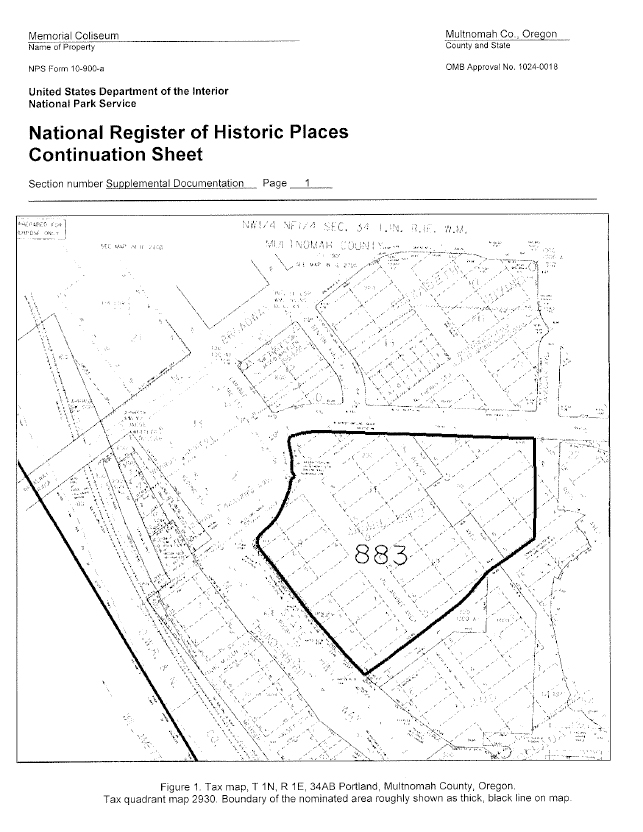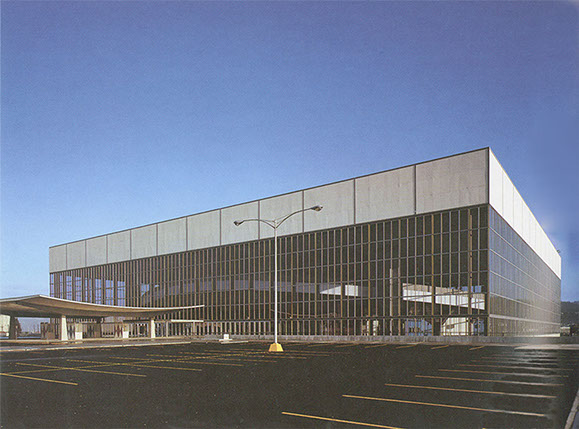

Due to the transparency of the exterior of Veterans Memorial Coliseum, the interior of the building, especially the Arena seating bowl, is a key part of the exterior.
Historic Review Summary
For significant projects at Veterans Memorial Coliseum, because it is on the National Register of Historic Places, there would be reviews in the City of Portland that would include public hearings and rulings by the Historic Landmarks Commission (see below) and potentially City Council and LUBA. For Historic Tax Credits, there would be a ruling by the National Park Service, after securing comments and recommendations from the Oregon State Historic Preservation Office (see further information below).
Veterans Memorial Coliseum is on the National Historic Register. The entire building is registered (exterior, arena, concourse, conference rooms, courtyards (aka sunken plazas), entry canopy, as well as the surrounding site as shown on the map to the left (figure 1 of the application for National Register of Historic Places - approx. 7.24 acres). The Lower Level Meeting Rooms have been ruled to be part of the registration by the National Park Service, superseding the last sentence of the National Register application Paragraph 1, Section 5, Page 5.
A building being on the National Register does not in itself necessarily protect the building from demolition or alteration.
Historic Tax Credits could be available for the restoration of Veterans Memorial Coliseum, and are certainly a wise idea to help fund a restoration. The Tax Credit program is run through the US National Park Service (NPS). A plan for the restoration of a historic building in Oregon would be first sent to the Oregon State Historic Preservation Office (SHPO) for review, comment and recommendations. Then, with SHPO comments, the plan would be sent to NPS for review and approval. For information on Tax Incentives for Preserving Historic Properties click here.
City of Portland
In Portland, if a historic property is listed on the National Register, it is classified as a 'Historic Landmark' by the City of Portland. Alterations to a Portland Historic Landmark would require Historic Resource Review.
Historic Resource Review: Major reviews (it is assumed that any VMC project will be a major review) are processed through a Type III review which requires a public hearing with a decision by the Historic Landmarks Commission. Per Zoning Code table 846-1, this includes 'Alterations of a landmark-designated interior public space' and/or 'any other non-exempt exterior alteration or historic restoration proposals' over $407,700. For landmarks, the approval criteria contained in Zoning Code 33.846.060.G are used. This includes 'retaining and preserving historic character', and 9 other criteria.
Demolition Review: For a building like VMC to be approved for demolition, it would go through a Type IV process, and the owner would have to prove that it would deprive the owner of all economic use, or that the demolition is supportive of the goals of the Comprehensive Plan. (33.846.080). The City Council would have to approve the demolition. The City has the right to deny demolition.
For a summary of Portland Historic Resources Zoning Regulations click here.
For information on Historic Landmarks from the City of Portland Bureau of Planning and Sustainability, click here.
VMC is in the Central City plan district and in the CXd zone (requiring design review). For maps click here.
Oregon Revised Statute (ORS) 358.653 is an Oregon state law obligating state agencies and all “political subdivisions” of the state—including cities local taxing districts—to consult with the State Historic Preservation Office (SHPO) to avoid inadvertent impacts to historic properties for which they are responsible. Impacts are usually the result of construction projects. The law requires that an owner work out a presentation plan with SHPO. ORS 358.653 does not include any penalties at this time for non-compliance. For a fact sheet on ORS 358.653, please click here.
